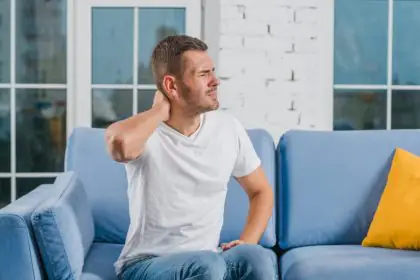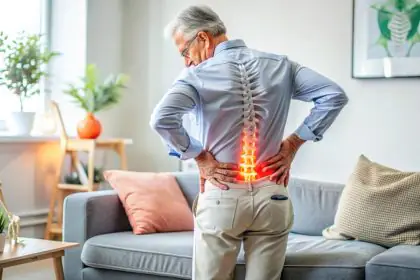Pain on the left side above the hip could stem from various causes, some of which might be relatively benign, while others could signal a more serious issue.
The Effects
The effects of pain on the left side above the hip can vary depending on the underlying cause and the severity of the pain.
Here are some potential effects:
Discomfort and Reduced Mobility
Pain in this area can cause discomfort and limit your ability to move freely.
Depending on the cause, even simple activities like walking or bending may become challenging.
Impact on Daily Activities
Severe or persistent pain can interfere with daily tasks and activities, affecting your ability to work, exercise, or even perform routine chores.
Emotional Impact
Chronic or severe pain can lead to emotional distress, causing anxiety, frustration, and even depression, particularly if the pain affects your daily life or if there’s uncertainty about its cause.
Sleep Disturbances
Pain can disrupt sleep, leading to fatigue and potentially exacerbating the overall impact on one’s well-being.
Secondary Symptoms
Depending on the underlying cause, additional symptoms might accompany the pain, such as nausea, fever, digestive issues, or urinary problems, which could further impact overall health and comfort.
Reduced Quality of Life
Constant or severe pain can significantly reduce one’s quality of life, affecting social interactions, work performance, and overall well-being.
5 Reasons Why
Pain on the left side above the hip could stem from various causes, some of which might be relatively benign, while others could signal a more serious issue.
Here are a few potential reasons for this type of pain:
Muscle Strain
Muscle strain in the area above the left hip can cause pain due to overexertion, sudden movements, or overstretching of the muscles.
Here’s how it happens:
- Overuse or Injury:
Engaging in activities that the body isn’t accustomed to or overexerting certain muscles through physical activity can lead to strain.
For example, sudden movements, lifting heavy objects, or participating in sports that require a lot of twisting or bending can strain the muscles in the hip area. - Tearing or Overstretching:
When muscles are pushed beyond their limits, tiny tears can occur in the muscle fibers.
This causes inflammation and pain. The left side above the hip can be particularly prone to strain if the muscles in this area are suddenly used in an unfamiliar or excessive way. - Symptoms:
Muscle strain can result in localized pain, tenderness, swelling, and reduced mobility in the affected area.
You might feel discomfort or pain when moving, especially during activities that involve the muscles in that specific area. - Recovery:
Rest, applying ice or heat, and over-the-counter pain medication can often help alleviate muscle strain.
It’s important to allow the muscles time to heal and avoid activities that may exacerbate the strain.
Digestive Issues
Digestive issues can cause pain on the left side above the hip due to the interconnected nature of the digestive system and its proximity to the abdominal area, which includes the left side above the hip.
Several conditions can result in this kind of pain:
- Gas and Bloating:
Accumulation of gas in the colon can cause discomfort and pain.
This can lead to bloating, which may cause pressure and pain in various parts of the abdomen, including the left side above the hip. - Constipation:
When stool moves slowly through the colon or becomes impacted, it can cause significant discomfort.
The pain can radiate to different parts of the abdomen, including the left side. - Inflammatory Conditions:
Conditions like diverticulitis, where small pouches in the colon become inflamed or infected, can cause sharp pain on the left side above the hip. - Gastrointestinal Disorders:
Conditions like irritable bowel syndrome (IBS) or inflammatory bowel disease (IBD) can cause abdominal pain that might be felt in the left side above the hip due to their impact on the entire digestive system. - Referred Pain:
Sometimes, pain from organs near the affected area, such as the spleen or the lower part of the stomach, can be felt in the left side above the hip due to a concept known as referred pain, where pain is felt in a different area than the source.
If you’re experiencing digestive issues accompanied by persistent or severe pain, changes in bowel habits, blood in stool, or other concerning symptoms, it’s crucial to seek medical advice to determine the underlying cause and appropriate treatment.
Reproductive Organ Issues
Reproductive organ issues, particularly concerning the left side, can lead to pain above the hip due to the proximity of certain organs and their potential to cause referred pain.
Here’s how reproductive organ issues could contribute to pain in this area:
- Ovarian Problems:
For individuals with ovaries, issues such as ovarian cysts, ovarian torsion (twisting of the ovary), or ovarian inflammation can cause pain.
This pain might radiate to the left side above the hip due to the positioning of the ovaries. - Fallopian Tube Issues:
Conditions affecting the fallopian tubes, such as an ectopic pregnancy (where a fertilized egg implants outside the uterus, often in a fallopian tube), can cause pain that might be felt on the left side above the hip. - Menstrual Pain:
Menstrual cramps or dysmenorrhea can cause discomfort and pain that might radiate to the hip area. While the uterus is midline, the pain can sometimes be perceived on either side. - Referred Pain:
Reproductive organ issues, like other conditions, can cause referred pain, where the pain is felt in an area other than the source.
For example, issues with the left ovary might cause pain that’s felt in the left side above the hip due to the way nerves transmit signals.
Kidney Stones
Kidney stones are solid deposits of minerals and salts that form inside the kidneys.
When they move out of the kidney through the ureter, they can cause intense pain, known as renal colic.
The pain caused by kidney stones might be felt in various areas, including the left side above the hip, and here’s how it happens:
- Ureter Obstruction:
As a kidney stone moves through the ureter (the tube that connects the kidney to the bladder), it can get stuck or lodged, leading to an obstruction in the urinary tract.
This causes the muscles in the ureter to spasm and try to push the stone out, resulting in intense pain. - Radiating Pain:
The pain often starts in the lower back, below the ribs, on either the left or right side, depending on which kidney is affected.
As the stone moves down, the pain might radiate from the back to the front and towards the groin.
This can lead to pain in the left side above the hip as the stone progresses through the urinary tract. - Referred Pain:
Sometimes, the pain from kidney stones can be felt in different areas due to referred pain.
Pain signals can be perceived in locations other than the source, which might cause discomfort in the left side above the hip even though the stone is not directly affecting that area.
Hernia
A hernia occurs when an internal organ or tissue bulges through a weak spot in the surrounding muscle or tissue.
Depending on the type of hernia, it can cause pain in the left side above the hip for the following reasons:
- Inguinal Hernia:
This is the most common type of hernia and occurs when part of the intestine pushes through the abdominal wall, usually in the groin area.
However, the discomfort from an inguinal hernia might be felt in the groin and can sometimes radiate towards the left side above the hip. - Femoral Hernia:
Less common than inguinal hernias, a femoral hernia occurs when tissue, usually part of the intestine, protrudes into the canal that carries the femoral artery.
This type of hernia might cause pain that’s felt in the upper thigh and groin area, potentially radiating to the left side above the hip. - Incisional Hernia:
These hernias happen through a previously surgically created incision or scar in the abdominal wall.
Depending on the location of the incision, the pain might be felt in the left side above the hip if the hernia occurs in that area.
The Complications
Complications from pain on the left side above the hip largely depend on the underlying cause.
If left unaddressed or if the cause is a serious medical condition, complications might include:
Worsening of the Underlying Condition
Ignoring the pain or delaying treatment could lead to the progression of the condition causing the pain, potentially leading to more severe health issues.
Reduced Quality of Life
Persistent pain can significantly impact daily activities, work, and overall well-being, leading to a decreased quality of life.
Mobility Issues
Severe pain might limit movement and mobility, affecting your ability to perform regular tasks or participate in activities.
Emotional Impact
Chronic or severe pain can lead to emotional distress, including anxiety, depression, or frustration due to the impact on daily life.
Complications Specific to Underlying Causes
For example, with digestive issues, complications could include bowel obstructions or worsening inflammatory conditions.
With reproductive organ issues, complications might involve fertility problems or potential damage to the reproductive system.
Kidney stones could lead to urinary tract infections or kidney damage.
Risk of Misdiagnosis
If the underlying cause is not properly diagnosed, there’s a risk of mistreatment or prolonged suffering.
These complications can vary in severity and impact depending on the cause and individual health factors.
Seeking medical attention and proper diagnosis for persistent or severe pain is crucial to prevent potential complications and address the root issue effectively.
How to Prevent Pain on the Left Side Above the Hip?
Preventing pain on the left side above the hip involves adopting healthy habits and addressing potential risk factors associated with various causes.
Here are some general preventive measures:
Maintain a Healthy Weight
Excess weight can strain muscles and increase the risk of various conditions that might cause pain in the hip area.
Stay within a healthy weight range through proper diet and regular exercise.
Exercise and Stretching
Engage in regular physical activity to strengthen muscles and improve flexibility.
This can reduce the risk of muscle strains and other musculoskeletal issues. Focus on exercises that promote core strength and stability.
Proper Posture
Maintain good posture, especially while sitting and standing, to alleviate strain on muscles and reduce the risk of developing muscular discomfort.
Lift Correctly
When lifting heavy objects, use proper lifting techniques, such as lifting with your legs instead of your back, to prevent muscle strains or injury.
Healthy Digestive Habits
Maintain a balanced diet with adequate fiber and hydration to prevent constipation and promote healthy digestion.
This might reduce the risk of gastrointestinal issues causing pain.
Regular Health Check-Ups
Regular visits to healthcare providers can help detect and address potential health issues before they escalate and lead to pain in the left side above the hip.
Avoid Repetitive Strain
Be mindful of repetitive activities that might strain the muscles in that area.
Take breaks and practice good ergonomics in your work or daily activities.
Seek Medical Attention Promptly
If you experience any unusual or persistent pain in the left side above the hip, seek medical advice promptly.
Timely diagnosis and treatment can prevent worsening of conditions.
Preventive measures can significantly reduce the risk of experiencing pain in the left side above the hip, but it’s essential to address any unusual or persistent discomfort promptly to prevent potential complications.
Conclusion
Pain on the left side above the hip can stem from various causes, ranging from relatively benign issues like muscle strains or digestive discomfort to more severe concerns such as kidney stones, hernias, or reproductive organ problems.
The effects of this pain can impact daily life, causing discomfort, reduced mobility, emotional distress, and potential complications based on the underlying cause.
Understanding the potential sources of this pain—whether musculoskeletal, digestive, reproductive, renal, or related to hernias—highlights the need for timely medical attention.
Seeking proper diagnosis and treatment is crucial in addressing the root cause and preventing complications that might arise from ignoring or delaying care.
Prevention, through healthy habits, including exercise, maintaining a healthy weight, good posture, and regular check-ups, can significantly reduce the risk of experiencing pain in the left side above the hip.
Early intervention, prompt medical attention, and addressing the underlying cause are key in managing and alleviating this discomfort, ensuring a better quality of life and overall well-being.
FAQs
What are the common causes of pain on the left side above the hip?
Causes can include muscle strains, digestive issues, kidney stones, reproductive organ problems, and hernias.
What complications could arise from this type of pain?
Complications might range from reduced quality of life to the worsening of underlying health conditions if left untreated.
How can one prevent pain in the left side above the hip?
Prevention involves maintaining a healthy weight, regular exercise, good posture, and seeking timely medical attention for any persistent discomfort.
What should one do if experiencing this type of pain?
Seek medical attention for proper diagnosis and treatment, especially if the pain is persistent or severe.
What effects can this pain have on daily life?
It can cause discomfort, reduced mobility, emotional distress, and potentially hinder daily activities.
Why is early intervention important in addressing this pain?
Timely intervention aids in identifying and treating the underlying cause, preventing potential complications.





